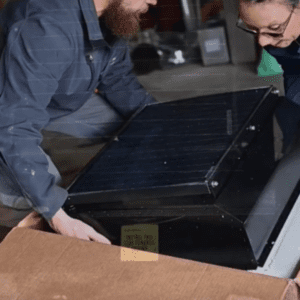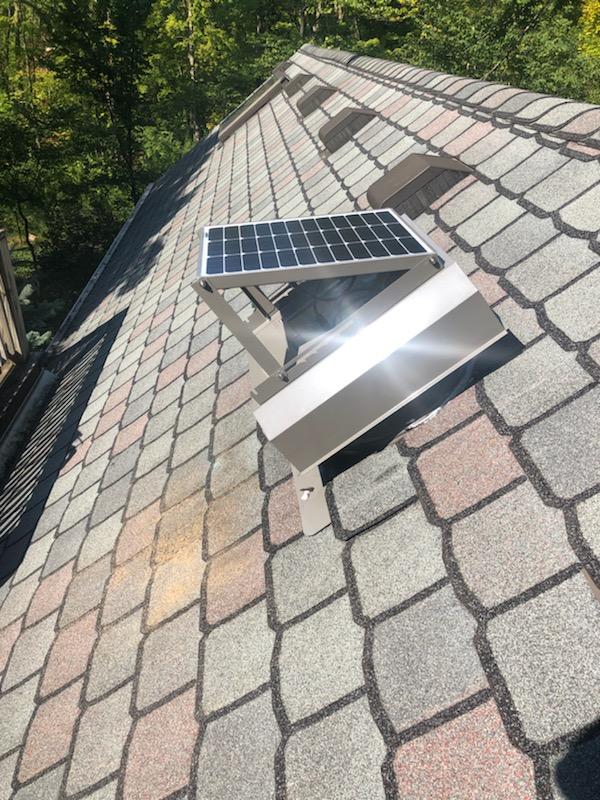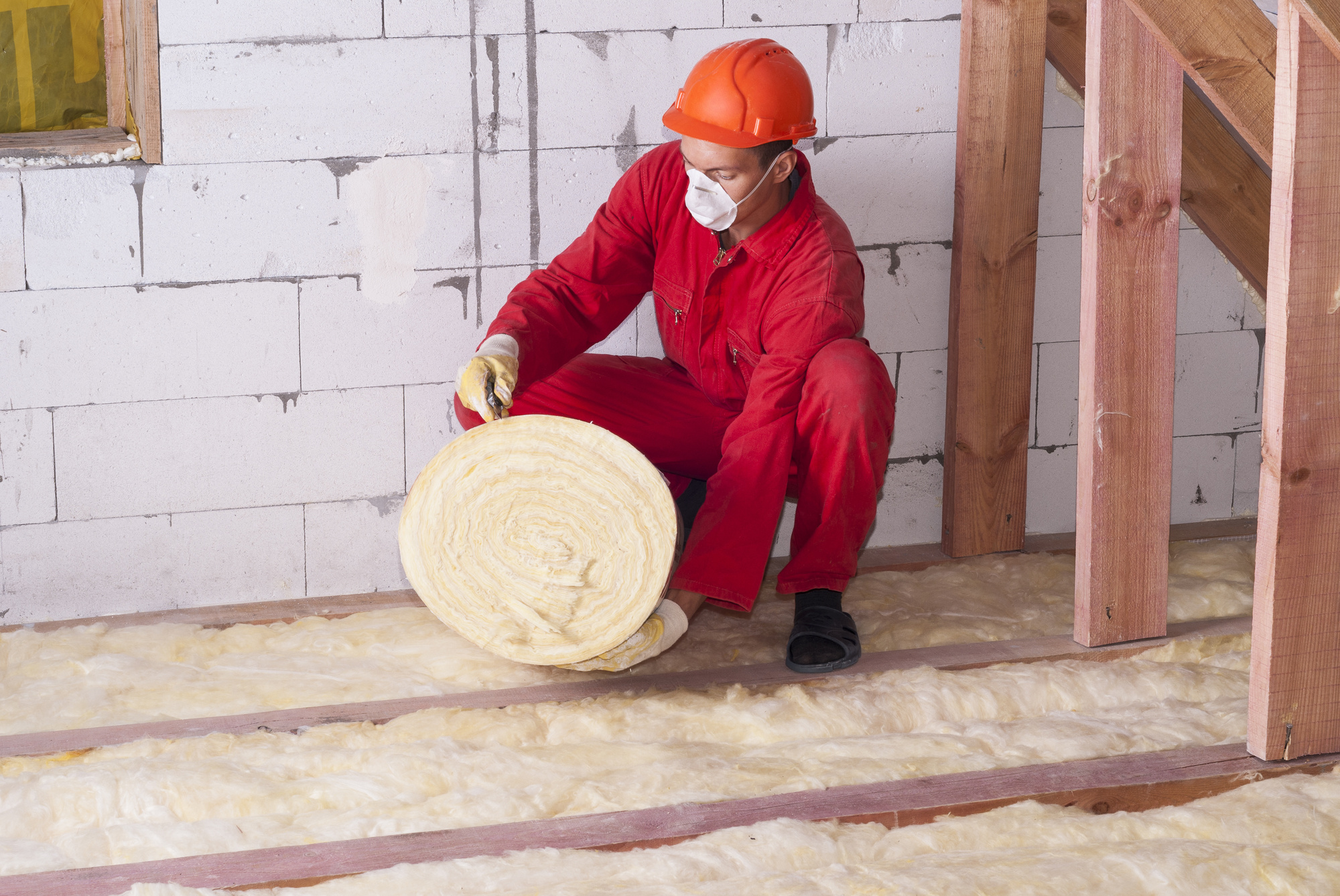Are Solar-Powered Attic Fans Worth the Expense?
If you’ve ever been in your attic during warmer months, you know it can be HOT up there. With all the heat rising from your home pushing up into the attic, and the sun warming the roof and pushing down into the attic, you’ve got the makings for a sauna. But, unlike an intentional sauna, you can’t control the temperatures in your attic… or can you? That’s where solar-powered attic fans can come to the rescue!
How do solar-powered attic fans work?
Solar-powered attic fans use energy from the sun to power a motor, which rotates a fan blade to circulate air in the attic. The fan helps to remove hot air from the attic, which can reduce the temperature in your attic and the workload on your home's air conditioning system. Ultimately, not only will you lower the temperature in your home, but your energy bills too!
Are solar-powered attic fans worth the investment?
 Yes! After your initial installation cost, it’s only savings and benefits from there on out!
Yes! After your initial installation cost, it’s only savings and benefits from there on out!
• Energy savings: Solar attic fans are powered by the sun, which means they don't rely on electricity from the grid. This can result in significant energy savings over time, especially during the summer months when attics can become hot and stuffy.
• Improved air circulation: Attic ventilation is important for maintaining the health and longevity of your home's roof, as well as preventing moisture buildup and mold growth. A solar attic fan can help improve air circulation by drawing fresh air into the attic and pushing hot, stale air out.
• Increased comfort: By reducing the temperature in your attic, a solar attic fan can also help make your home more comfortable during hot weather. One of the biggest complaints we hear is that it’s hot on a home’s second floor; a solar powered attic fan can significantly reduce the temperature swing between floors by taking the heat load off the upstairs!
How are they installed?
Solar-powered attic fans are typically installed by cutting a hole in the roof and securing the fan to the underside of the roof using brackets or screws. (This isn’t a job for a casual DIYer… you want a professional for this to ensure proper installation and prevent damage to your roof!) The fan is then connected to a solar panel which is mounted on the roof.
How much do attic fans cost to operate?
Not a dime! Once installed, the solar panel does all the work to power the fan and keep your attic cool!
Attic Fans in the Indianapolis Area
If you’re ready for an earth-friendly way to reduce cooling costs in your home and increase your comfort, contact us to learn more and to get a quote for installation!
SEER2: What it Means for You
What is SEER2?
First, we’ll start with SEER: SEER stands for Seasonal Energy Efficiency Ratio. This ratio, or rating, is set by the US Department of Energy (DOE) on equipment efficiency for air conditioners and heat pumps. Basically, the higher the SEER rating, the less electricity is required for the equipment to do its job. Something related to SEER that you may be more familiar with is Energy Star certification: for example, air conditioning units that receive SEER ratings of 14 or more may qualify for Energy Star certification. “SEER2” is the newest iteration of this ratio, and with this new iteration comes new requirements.
What are the new SEER requirements?
As of January 1, 2023, the new minimum SEER requirements on air conditioners is 13.4 and 14.3 on heat pumps.
Why are there new SEER requirements?
The DOE periodically evaluates current technology, efficiency, and the cost of that technology to determine the right balance in ratings. As these things change, the measures used to determine the ratings must be adjusted as well.
With the new testing requirements, equipment measured with these updated standards (SEER2) is significantly more efficient than those with a similar rating measured by the old (SEER) standards.
How will SEER2 affect me?
Existing systems installed prior to January 2023 are not affected, so no worries if you’ve recently had a new system and aren’t looking to have one installed. Only systems installed after January 2023 will be subject to the new SEER2 standards.
If you fall into the category of looking to replace your system now, and you were already interested in a higher efficiency system, you really won’t notice any kind of impact. However, if you are looking to replace a system with more of a base model, you may have to upgrade the system you install compared to what you may have installed in previous years.
Select the image above for Renee's explanation of SEER2!
SEER2 in the Indianapolis Area
If it’s time for you to install a new system, contact us today. LCS Heating and Cooling can help you navigate any questions you have related to SEER2 and help you determine an affordable lasting comfort solution for your home!
6 Factors to Consider When Choosing a Home Insulation Company
Does your temperature fluctuate the moment you turn your heater off? Do you feel like you can hear everything going on outside, even that squirrel eating? It might mean your home insulation isn't as good as you think.
With temperatures in Indianapolis, IN getting as low as three degrees Fahrenheit, it's crucial to know you have a home insulation company you can rely on.
Keep reading to learn the six factors to consider when choosing a home insulation company.
1. Determine Your Budget
Depending on what you're looking to insulate, a project can cost as much as $10,000. Determine what your budget is and start there so you don't end up getting blindsided by the price tag.
When comparing contractor fees you also need to look at the cost of different types of insulation, and what you need to be insulated. These factors are going to change the price quite a bit, so try making a list of everything you need.
2. Ask Friends and Family
When you start searching for companies ask your friends, family, and neighbors. Chances are they've had to do something similar and they might have a company they recommend. This is one of the easiest ways to find a reputable company.
3. Read Reviews
Once you've found a couple of companies to look at read their references and reviews. Checking the reviews from the past three months would be an appropriate place to start. If there are more positive than negative reviews you may have found a good company.
4. Insured and Licensed
This goes for any contractor you let into your home. Always ensure they are licensed and insured. Ask them to show you their licenses or their insurance to be sure you're protected if something goes wrong.
5. Have Home Insulation Experience
This seems obvious, but you really need a company that has experience doing this type of work. Look for companies that focus on home insulation or similar services so you know they can get the job done.
Check out their website to see if they have pictures of the services, or ask them about their experience doing what you're asking. They should have no problem explaining everything they're going to do to your home.
6. Focused on Customer Service
Once you've found a company that meets the above requirements you should make sure that they're focused on giving you the best customer service possible. It's not enough to know what they're doing, they also should be willing to answer your questions and respect your home.
Hire a Home Insulation Company Today
Now that you know the six factors to consider when choosing a home insulation company, hire one today!
If you're in the Indianapolis, IN area, contact us or give us a call, we would love to help. We pride ourselves on offering the best customer service you've ever experienced. When the process is stress-free for you, we know we've done our job right.
Energy savings are usually a year-round concern for homeowners. You want to keep costs down, but still maximize your comfort. That’s where efficiency comes into play. Whether your HVAC system is heating or cooling your home, it always helps to keep on top of your maintenance plans. When you run the numbers with a truly efficient system, it’s easy to see how you can keep those energy costs low.
Utility Costs and Efficiency Ratings
In the state of Indiana, our average residential electricity rate is around 10.5 cents/kWh. To keep things simple, let’s just say you pay $100/month to power your home’s HVAC system. You might look at your utility bill and think that it’s an accurate statement for what you spend to heat your home in the winter or cool it down during the summer. But in reality, the equation is a little more complicated. The amount of money you spend isn’t just about the local utility rates. You also have to consider your equipment’s efficiency rating.
For units that are older, you might be looking at 80% efficiency. That means your costs can get pretty high because for every $100 you spend to heat your home, you’d essentially let $20 fly away. A furnace that’s operating at 95%, on the other hand, would only lose $5. The other $95 would go directly into heating your home. That’s why efficiency is key. If you’re living with an older furnace, heat pump, or air conditioner, you’ll have to think about these hidden costs. Your energy bill is likely higher than it should be.
Realistic HVAC Costs: Repair vs Replace
Having a general idea of where your HVAC equipment’s efficiency ratings are can help inform your decision for any repairs later on. Say your air conditioner doesn’t work like it should after the winter season wraps up. Will you need to invest in a completely new system? Hopefully not, but it all depends on the age of your AC unit and the repair costs. Thinking about those two factors will help point you in the right direction for whether to get HVAC repairs or a total replacement.
Here's one example to consider: A $500 repair on a 6-year-old system makes more sense than a $500 repair on a 16-year-old system. While you're spending the same amount of money, the chance of there being more repairs on that older system is pretty high. Sure, the upfront cost of a new system is more than the repair itself, but there's peace of mind with a warranty. Plus, you can look forward to those potential utility cost savings with a higher efficient system.
Ready for an Efficient HVAC System?
You’re probably already aware that changing your HVAC filter goes a long way for improving efficiency. But there are other ways to get energy savings too. Annual cleaning and tune-up services for both your furnace and air conditioner keep your systems running smoothly. Then you can limit your risks of having a bigger problem pop up down the road.
It might help to think of your HVAC annual maintenance like the regular oil changes and tire rotations you get for your car. (Plus, annual maintenance is what keeps your manufacturer and labor warranties in place.) Your equipment will work better when you just do a few simple things. To streamline the process, we offer our customers two different types of annual plans. It’s a low-cost investment for big rewards.
Our LCS Gold Membership includes two services each year: one cooling tune-up for your air conditioner, and the same for your furnace. It also gives you $20 off your regular-hours service calls, waives that service call for repairs over $300, gives you discounts on duct cleaning and indoor air quality products, and more. The membership is just $155 per year, and helps ensure that your equipment is running at its best—so you get the best savings on your energy bills.
Our LCS Platinum Membership includes those same maintenance services, but waives the service call with paid repairs completed during regular business hours. It also gives you discounted rates for after-hours service, a one-year supply of air filters, up to $700 in savings on a full system replacement, and more. To learn more about your HVAC repair options and how to improve your energy efficiency, please visit our webpage for annual maintenance plans. We look forward to serving you!
February 18, 2020
When the heatwaves start heading in, we all want to have a cool place to retreat indoors. Of course, we’d rather not drive up our energy bills to keep things comfortable! A little common sense can help you manage your cooling costs this summer. Use these tricks to get the most out of your AC unit—especially during triple-digit days outside.
1. Adjust your ceiling fans
One way to better regulate your indoor temperature is to change how your ceiling fan blades rotate throughout the year. In the winter, we want warm air to circulate. Adjusting your fan so it pulls air up encourages cooler air to mix with the heat that rises to your ceilings, making your room feel warmer. On most ceiling fan models, this happens when the blades run clockwise.
For the summertime, though, it’s better to have air moving down and away from the fan. The angle of your blades impact which direction they should spin this time of year, but typically it’s counterclockwise. This will add a cool breeze in your room—which is a nice bonus to how your AC is already working.
To test this, all you have to do is stand beneath the ceiling fan. If you feel cool air blowing down on you, then you’ll know you’re set! Otherwise, just flip the little switch on the base of your fan. This will tell the blades to move in the opposite direction. Run your fan on high during hot days, and you’ll really put them to good use!
2. Turn on the exhaust fans
The next thing to watch for in summer is how you manage the hot air in your kitchen and bathroom. Warm showers and hot cooktops add extra heat to your home. Being able to push that air outside can help keep things cooler.
The primary function of your exhaust fan in the bathroom is to reduce your risk of growing mold and mildew in the bathroom. You can turn it on to minimize that muggy, humid feeling. This is important when you’re creating steam in the shower, but it also benefits your home’s AC. You can turn on your exhaust fan whenever the air in the room is feeling thick.
This works for your kitchen too. Use your exhaust fan to pull heat away and out of the room. You don’t have to run these fans for long to make a difference. And when the weather is smoldering outside, every little bit counts.
3. Watch your open doors
Another way to reduce the heat in your home is to keep that cool air in its place—inside! Going in and out of the house for chores in the backyard just gives that cold air more chances to escape. Then your AC has to work harder to make up the difference. The same can be said about your garage door. We see a lot of people leave it up when they’re at home. Again, that just creates opportunities for the hot summer weather to impact your temperature indoors. Keep that garage door down so it becomes another barrier against the heat.
Of course, if you have dramatic temperature swings throughout your home, it might be time to consider other solutions. Looking into zoning for your home can be a great way to direct how your AC and furnace work throughout the year. You divide rooms or levels into distinct zones. This gives each area its own thermostat. Then you can really have control over the temperature in your home.
Hopefully you’ve already gotten your AC unit serviced for the hot weeks ahead, but if not, you can always give our team a call at (317) 238-3961. We’d be happy to come out and get your home (or business!) squared away. After that, just follow these easy tips to keep cool this season. Your air conditioner will thank you!
August 6, 2019
The cool air, turning leaves, and arrival of apple cider at the store mean that autumn’s official start is just around the corner. At home, this seasonal change can quickly translate into higher energy bills. Fortunately, there are a few ways to lower these costs. Staying comfortable in your home—at an affordable rate—is relatively easy when you opt for energy-efficient solutions.
Schedule Your Heating Tune-Up
This time of year, the biggest energy bills for your home relate to heating. In order to get the best efficiency rating for your furnace, it needs to be able to run smoothly. Any problems during this season can be a real issue for your overall costs. But you can catch issues early on by scheduling your heating tune-up. This service helps ensure that all of your system’s components are within the normal operating range. That way, if any part is having trouble, you can have the option to be pro-active for a repair or replacement. And this could save you a service call down the road!
At LCS Heating & Cooling, we offer Annual Maintenance Plans to help keep service and energy costs low year-round. Getting notified of any potential problems lets you stay up-to-date on your furnace’s needs. When you look ahead to winter, no one wants to be caught without heat. A quick visit from your local HVAC company can help you avoid that inconvenience before the cold snap.
Other Home Efficiency Tips for Fall
Once your furnace is in order, you can still work to lower costs in other ways. Adding these efficiency tips to the mix can help you finish the year with extra energy savings. Try them all for the biggest benefits, or just stick to a few to get the ball rolling.
1. Change your air filter
We always recommend preventative maintenance to prep your home. But if you do nothing else this season, replace your air filter. It’s important to swap out your 1-inch air filter every 1-2 months. (The larger 4 to 5-inch media filters can last for 6-12 months.) This simple step goes a long way for your unit’s overall efficiency. A dirty filter can put a lot of strain on your heating unit and make it harder for the warm air to circulate through your home.
2. Warm up with the sun
The days and nights are getting colder, but the sun is still shining. Make the most of sunny days by opening your curtains to let this natural heat inside. South-facing windows tend to have the most impact. Just keep your curtains closed when the sun is set to hold in the warmth, then pull them back in the morning to create some sunny spots. This will help boost your home’s temperature. Plus, it gives your dog or cat a great place to nap!
3. Adopt a smart thermostat
When you want to go above and beyond for your home energy savings, a new thermostat can be a real winner. A programmable thermostat is a great investment because it lets you set schedules for your heating and cooling programs. You’ll get more efficient ratings, for instance, when you tell the heat to drop slightly in the evening, or when you’re away at work. A smart thermostat is even better because you can control your home’s settings right from your phone.
4. Grab some free LED bulbs
Changing your old lightbulbs to LED versions is a fantastic way to cut costs on your energy bills because they use up to 66% less energy. They even last over 20 times longer than standard bulbs. The best part about these updates? You can get LEDs for free! The Free LED Program from Duke Energy will ship bulbs right to your home. The potential savings could be upwards of $100, so there’s no reason to pass up this deal.
5. Watch for home air leaks
Feeling a cold air draft around your windows or outside doors indicates a heating leak. Don’t let these spots add to your energy bill. Adding fresh caulk around these borders or replacing the weatherstripping can prevent your home’s heat from escaping. The other thing to check is your fireplace damper. Make sure to always keep this closed when your fireplace isn’t in use. Accidently leaving it open is just another way to lower your indoor temperature.
Take this advice, and you’re sure to have a more energy-efficient home for the colder months. What’s more, you’ll be able to enjoy upgrades like a smart thermostat during the warmer months as well! If you have questions about other energy savings solutions for your home, give LCS Heating & Cooling a call at (317) 238-3961. We’d be happy to help you out!
September 17, 2018
There are all sorts of ways to help make your space more comfortable this time of year. After all, this is the season for cuddling up with hot cocoa! If you’re concerned about climbing energy bills, fear not. Keeping cozy all through the winter relies on a lot more than just your thermostat settings.
1. Winter Home Energy Efficiency
Of course, having a good furnace or heat pump is crucial this time of year. (Be sure to call us at 317-238-3961 if you need a hand!) But even if all of that equipment is working fine, you can still make your home a little more snug with one of these energy-saving wintertime tips. A quick home improvement project can make a big difference to boost your home’s efficiency ratings.
Locate and Fix Leaks
Warm air can escape through leaky doors and windows. If it feels like you’re always getting a slight draft around these spots, it’s probably time to add new caulk or weatherstripping. This will help keep your heat inside, where it belongs. You’ll also want to look for any gaps around the chimney and remember to keep the fireplace damper firmly shut whenever it’s not in use.
Find Your Sunny Spots
You can also save money by making the most of the sunlight that hits your home. One simple trick is to keep your curtains open on south-facing windows. When the sun is bright, your home can heat up naturally and help you save energy. Then at night, just draw your shades and other window treatments to lock in the warmth. This lets your curtains work as an extra barrier to hold back cold drafts.
Buy a Better Thermostat
Turning down the temperature when you aren’t at home can help you get some additional energy savings. For a lot of homeowners, the best way to get these benefits is with a programmable thermostat. These gadgets are great investments for homeowners looking to lower their energy bill for the long-run. A programmable thermostat lets you set a schedule for your heating and cooling equipment, so you can get the best efficiency every day of the week.
2. Whole-Home Humidifier Benefits
Outside of high energy bills, another nuisance during the winter tends to be dry air. Dealing with scratchy throats can put a really damper on your holiday spirit. (Not to mention getting static shocks whenever you pet the cat or dog.)
Dry air also leaves our skin feeling dry and chapped in winter. Instead of relying on lotion alone, we like whole-house humidifiers. Unlike portable units, these systems address dry air problems in every room. Having proper humidity levels all throughout your home helps give you softer skin, less static, and better breathing all winter long.
As an added bonus, whole-house humidifiers also help make your home feel warmer. This is because dry air naturally seems colder than air with some humidity. By introducing a little more moisture into your air, your home can actually be more comfortable in winter—without even raising the temperature on your thermostat!
3. Smart Home Holiday Cooking
To really seal the deal on your home’s coziness, be sure to embrace home cooking. Whether you’re entertaining friends and family or just hanging out on a quiet night, spending a little time in the kitchen will definitely make your house feel more like a home.
Fixing meals in your crockpot is great this time of year because you can come home to a hot meal after checking out any one of your favorite winter activities around Indianapolis. It's even better if you're cozy at home while it cooks. The smells from your slow cooker can definitely help spread some cheer! Here’s a recipe for one of our favorites:
Crockpot Lentil and Pasta Stew
Preparation Time: 25 minutes
Cook Time: 8-10 hours
Serves: 8
Ingredients:
½ lb. smoked kielbasa sausage, chopped
3 Tbsp. olive oil
3 Tbsp. butter
1 cup cubed, peeled potatoes
¾ cup sliced carrots
1 celery rib, sliced
1 small onion, chopped
5 cups beef broth
1 cup dried lentils
1 cup uncooked ditalini (or other small pasta)
1 bay leaf
1 tsp. pepper
¼ tsp. salt
shredded romano cheese to serve
Directions:
- Brown kielbasa in oil and butter in a large skillet.
- Add potatoes, onion, carrots, and celery to skillet. Cook and stir for 3 minutes over medium heat.
- Transfer ingredients to a large slow cooker.
- Stir in broth, lentils, bay leaf, pepper and salt.
- Cover and cook on low for 8-10 hours, or until lentils are tender.
- Meanwhile, cook pasta according to package directions. Drain. Stir pasta into slow cooker. Discard bay leaf. Sprinkle with cheese and serve!
All of us here at LCS Heating & Cooling wish you a warm and bright holiday season! If you need any emergency help with your equipment, you can always give us a call at 317-238-3961.
December 21, 2017
When it’s cold outside, your heating units need to be able to keep you home comfortable. But if your furnace isn’t sized right for your home, you’ll just end up wasting money. Or worse—you’ll be dealing with a chilly “winter wonderland” inside!
Furnace Size and Ductwork
Most people tend to think that furnace size is only determined by square footage of their house. However, the biggest factor is actually the size of the ductwork. If your furnace size and ductwork don’t match up, you’re bound to have some problems.
For example, if the ductwork is too small for your furnace, the furnace will end up having a shorter lifespan than it should. The reason is because the amount of air that the furnace produces doesn't have enough space (ductwork) to travel through. Therefore, it restricts air flow and can eventually cause the furnace to overheat. To compare, it's kind of like driving a big truck with a MINI Cooper radiator in it.
If you want to get the best lifespan out of your furnace, you need to make sure it’s sized appropriately for your ductwork—not just your square footage. Experiencing any of the problems listed below is a sure sign that your equipment need a review.
Problems with Furnace Size
There are basically three possible scenarios for your home’s furnace size. You’ll either have a furnace that’s too big, one that’s too small, or a unit that’s sized just right for your home’s layout, the ductwork, and family needs. Keeping all these factors in mind will help you get an effective, energy-efficient setup.
Too Small
Having a furnace that is too small for your home means the system won’t be able to keep up with the dropping temperatures outside. They simply can’t make up the difference to heat your home properly. It might come with a lower price tag upfront, but the trouble of having a furnace that can’t even do its job isn’t worth the hassle.
When furnaces are too small, they’ll have to kick on often—or even non-stop—try to increase your indoor temp. They end up running and running, but without any real progress. This leads to excessively high energy bills, and not much help in making your home comfortable.
Too Big
Of course, a furnace that is too big won’t be much help either. When units are oversized for the space they’re heating, the furnace ends up working in quick bursts. They’ll turn on when the temperature is low and just end up creating heat pockets. Since the system works at full blast and heats some areas super-quickly, there isn’t enough time for the heat to travel throughout the home evenly.
The furnace then ends up turning on and off more times than is necessary. A few areas get toasty, and then the system turns off. Then, as that heat spreads out, the unit has to warm up again and start all over again. This makes over-sized furnaces really inefficient. For most homes, bigger units aren’t better.
Your Right-Size Furnace
A furnace that is appropriately sized for your home and needs will turn on and heat your space gradually. This makes the process much more energy-efficient and puts less strain on your equipment. If you’ve been noticing that your furnace is running non-stop, there’s a good chance it’s too small for your home. And if it’s constantly starting and stopping, you might be living with a unit that’s too big.
When you have a furnace that’s sized correctly for your home, you shouldn’t have to worry about any hot or cold pockets in your home. But even the most efficient systems aren’t totally fool-proof. On the coldest night of the year, your furnace may not be able to keep up. This is actually normal. Systems that plow through those sub-zero temps are likely working inefficient the rest of the year. You may need to throw another blanket on the bed during that extra-chilly spell, but at least you’ll know you aren’t over-paying for a unit that’s too big!
Finding the Perfect Fit
Working with an experienced local HVAC company is a great way to ensure you’ve got a heat pump or furnace that’s working with your home setup and ductwork—not against it. The best way to get the best heating system for your home is to work with the pros. An experienced HVAC technician can help you find the right-sized unit for your space and get it installed properly so it lasts longer and stays efficient.
Not sure if your system is running at peak efficiency? Contact LCS Heating and Cooling. We’re proud to provide our neighbors with great service and honest feedback. Give us a call at 317-238-3961 to schedule your Heating Tune-Up before the holidays hit. We’ll help keep your home comfy all year long!
October 19, 2017
Outdated dial thermostats prevent you from enjoying a comfortable (and fuss-free) home environment. For easy home upgrades, new tech is where it’s at!
The latest programmable thermostats are an easy upgrade for energy-efficiency. And a smart thermostat will even let you change your home’s temperature remotely. Depending on the model you choose, you can enjoy a few other perks, too.
About Programmable Thermostats
Most programmable thermostats include different settings based on the day of the week. This is great for homeowners who have a pretty consistent routine Monday through Friday. When your thermostat is set to your schedule, it will automatically adjust your indoor temp when you’re away, then bring it back to a comfortable level when you return.
As a general rule, you want your programmable thermostat to do the thinking for you. You don’t want to be worried about changing the temperature and checking in when you’re getting ready to leave the house. Programming your settings helps you save on energy costs when you don’t need that “perfect” indoor temp—like when the whole family is out running errands, working, or at sports practice.
Comparing Thermostat Models
When it comes to programmable thermostats, there isn’t always a clear winner. It usually just depends on what features would be most useful to you. Of course, some devices are made better than others. They might come with better warranties or have a more intuitive display. These factors should always be considered, as should price. You don’t want to pay for a model that doesn’t do everything you want—just like you wouldn’t want to overpay for a setup that does more than you need.
At LCS Heating & Cooling, we like to set our customers up with programmable thermostats. Hands down, our two favorite are Lennox and ecobee. They’re different enough to provide unique perks, and they’re also both easy to use. If you’re still dealing with a dial thermostat or some other inconsistent system, either one of these would be a sweet upgrade.
Lennox
If you’re already using Lennox equipment with your home's heating and cooling equipment, it usually makes the most sense to stay on-brand and go with the Lennox Smart Thermostat. We really like this unit because it holds your temp within a half a degree of your preferred setting. (Talk about precision!)
- Smart, programmable thermostat—compatible with all Lennox equipment
- Make temperature adjustments from your smartphone with the iComfort App
- Plus, the option to update the screen’s background display with a personal photo
The iComfort Wi-Fi setup can even be used to monitor the 5-day weather forecast and other key weather alerts. It’s also really user-friendly. The simple design also lets you adjust settings with one touch. That way, you can tap a button for both “Leaving Home” and “Returning Home” status as you head in or out the door.
Not sure about the one-touch option? The iComfort S30’s Smart Away mode can adjust your temperature settings for you by sensing when your smartphone enters and exits your home. If your thermostat notices that your phone is out of the house (presumably because you, yourself are away), it will know to tweak the temperature accordingly. The same thing happens when you’re at home. Because it can quickly coordinate with your activities in real time, you can be sure to get a great efficiency with your home’s heating and cooling.
ecobee
Tech-savvy homeowners really appreciate the communication style of the ecobee. These units come with an ultra-modern design and easily connect with your smartphone.
- Sleek designs and smart, programmable thermostats
- Options to sync with your Amazon Echo account or Alexa App
- Plus, the newest models come with room sensors to help monitor hot and cold spots
The latest ecobee 4 model comes with Amazon Alexa Voice Service already built-in, so it’s super helpful if you want to create a “smart” home. You can communicate with your Amazon account through the ecobee unit and ask it to order groceries, check the news, and more. The voice control is great for hands-free adjustments, like if you’re busy in the kitchen or on the other side of the room.
Need a break from the tech for a little while? You can always turn off the microphone for Privacy Mode. Because ecobee is designed with the end-user in mind, you can trust that customizing your settings will be a breeze. For a jump start, though, it can help to work with a professional for your thermostat install. They can help show you all the ins and outs of your new system, right from day one.
Professional Thermostat Installation
A lot of people don’t realize that they can get a better warranty with their new thermostat when they work with a local HVAC company or contractor. Because the major manufacturers offer different products to contractors, you’re more likely to get access to better models. That’s why it's usually better to skip the DIY and go with a registered dealer.
At LCS Heating & Cooling, we’re here to make the process easy for our customers. We’ll even register your new equipment for a 5-year part warranty and a 1-year labor warranty. You can get an even better warranty (up to 10 years) and extra savings if you get your new thermostat installed with new HVAC equipment. If you’re ready to make the switch, contact LCS to schedule your in-home consultation. We know you’ll love your new setup!
August 29, 2017
No one wants to spend more money on their bills. You should only pay for what you need, right? Yet some HVAC setups don’t work that way.
Every now and then, we see homes that consistently waste energy by heating or cooling rooms that you don’t even use. And when that happens, you end up overpaying on your energy bills. If your HVAC system can be organized the right way, you only use what you need. Your home’s warm or cool air can get directed where you actually want it. That way, you won’t get overcharged for your energy usage. The setup is called zoning.
About HVAC Whole-Home Zoning
Homes with HVAC zoning can regulate their energy usage much more efficiently. With these setups, your system won’t automatically heat or cool areas of your home that don’t need it. And without zoning? Well, it’s kind of like having every lightbulb in your home turn on when you flip the switch on your bedside lamp. You might only need a couple rooms cooled, but your HVAC is trying to lower the temp everywhere in your home.
Unfortunately, not all homes can be zoned. It just depends on how easily you can access your ductwork (since no one really wants to tear into their walls). But if your home does happen to be a good candidate for zoning, it’s a huge win. Because zoning lets you pick and choose where your heating and cooling efforts actually go, you’ll start raking in the savings right away. The systems themselves are pretty straightforward, too.
To start, your HVAC company would need to come out to analyze your home’s layout. Based on that information and your lifestyle, they’ll be able to designated “zones” for your home. Each zoned section would get its own thermostat to control that area. So, for example, if you don’t want to adjust the temperature in your guest room, a zoning system could be a great way to bypass heating or cooling that space.
Good Zoning System Strategies
Questions about why your home is warmer or colder upstairs vs. downstairs are pretty common in the HVAC world. This suggests that a lot of homeowners are already thinking about getting a zoning system before they even realize there’s a name for it! The following scenarios are all good signs that your home might benefit from this kind of setup:
- Multi-story home
- High, cathedral ceilings
- Finished living space in basement or attic
- Above-garage bonus room or apartment
- Lots of large windows, and/or sunroom
If you find a lot of temperature swings in different rooms of your home and you have one of the above home features, there’s a good chance zoning would be a smart upgrade—if your ductwork can support it. A consultation with your local HVAC company can help you know for sure.
Other HVAC Zoning Benefits
In addition to lower energy bills every month, whole-home zoning systems can also extend the life of your existing HVAC equipment. Lower demand results in less wear and tear on the heating and cooling elements throughout the year—all while getting a more comfortable home.
If you want an even better deal, consider connecting your zoned system with some programmable thermostats. When every aspect of your home’s heating and cooling is energy-efficient, you’ll start seeing some really significant savings. These types of upgrades make your home more desirable too, so even if you end up moving later on, you can still bank a solid ROI.
Got other questions about HVAC zoning? Homeowners in the greater Indianapolis area can always give LCS Heating & Cooling a call. We’d be happy to talk with you over the phone or in-person during an in-home consultation. Contact us today to get your appointment scheduled, and start getting the benefits of whole-home zoning for yourself!
June 28, 2017











